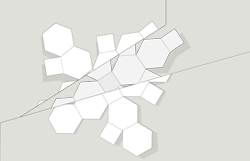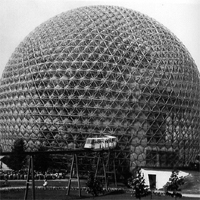

Context
 |
 Context |
| Architectural Visualization |
While none of us involved in this project are architects, our project draws on the history of avant-garde architectural visualizations as a framework to think about contemporary, collaborative, and interdisciplinary production. In particular, we draw on the visualizations of Buckminster Fuller. The fact that Fuller never had official training in architecture, art, or engineering parallels our effort. Moreover, the form of the geodesic dome, or in general an architecture that seeks to go beyond the stacking of cubes, provides inspiration for those seeking to produce unusual spatial forms using new technologies. |
|
| Art and Design |
Fuller had a concept called "design science" that encompasses a broad approach to creative production. Design science is not limited to fields such as architecture, industrial or graphic design, but also applies to modern art. Many conceptual artists of the 1960's, such as Sol LeWitt, made forms that were produced using aerospace technologies or other types of industrial manufacturing reminiscent of Fuller's geodesic domes, for example. Conceptualism, still a major force in contemporary art, places as much emphasis on the concept behind a thing as its aesthetic qualities. Much like mathematics and computer programming, the mental act involved in the process of making an object becomes the message of the piece. |
|
 |
  |
|
 |
 |
|
| Clockwise from upper-left: 1 Ernst Haeckel 2 Buckminster Fuller 3 Keith Crichtlow 4 D'Arcy Wentworth Thompson 5 Sol LeWitt |
|
|